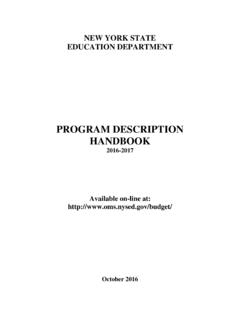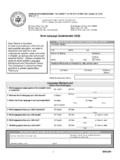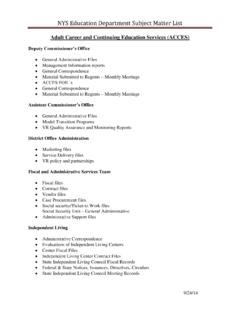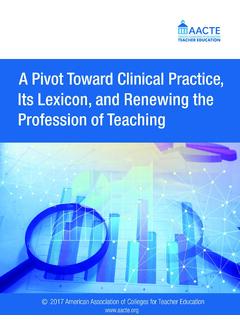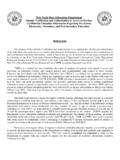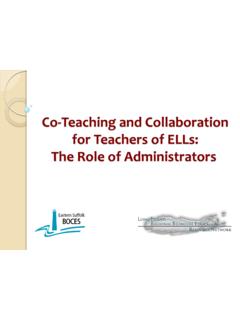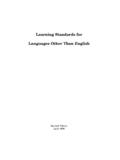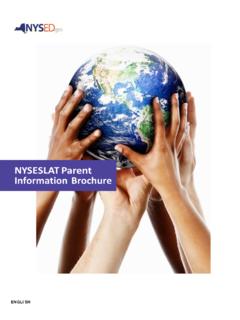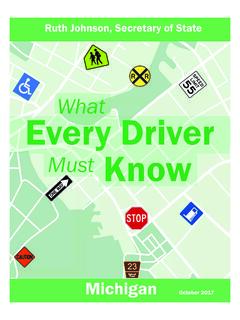Transcription of NYSED 1 Grade ELA Crosswalk Original 2011 ELA Standard ...
1 NYSED 1st Grade ELA Crosswalk Original 2011 ELA Standard 2017 Revised ELA Standard Standard code (2011). 1RF1 Demonstrate understanding of the 1RF1: Demonstrate understanding of the organization and basic features of print. organization and basic features of print. a. Recognize the distinguishing features 1RF1a: Recognize the distinguishing features of of a sentence ( , first word, a sentence ( , first word, capitalization, capitalization, ending punctuation). ending punctuation). 1RF2 Demonstrate understanding of spoken 1RF2: Demonstrate understanding of spoken words, syllables, and sounds (phonemes). words, syllables, and sounds (phonemes). a. Distinguish long from short vowel 1RF2a: Count, blend and segment single sounds in spoken single-syllable words.
2 Syllable words that include consonant b. Orally produce single-syllable words by blends. blending sounds (phonemes), including 1RF2b: Create new words by manipulating consonant blends. individual sounds (phonemes) in spoken c. Isolate and pronounce the initial, medial one-syllable words. vowel, and final sounds (phonemes) in 1RF2c: Manipulate individual sounds spoken single-syllable words. (phonemes) in single -syllable spoken words. d. Segment spoken single-syllable words into their complete sequence of individual sounds (phonemes). 1RF3 Know and apply Grade -level phonics and 1RF3: Know and apply phonics and word word analysis skills in decoding words. analysis skills in decoding words. a.
3 Know the spelling-sound 1RF3a: Know the letter-sound correspondences correspondences for common for common blends and consonant digraphs consonant digraphs. ( , sh, ch, th). b. Decode regularly spelled one-syllable 1RF3b: Decode long vowel sounds in regularly words. spelled one-syllable words ( , final e c. Know final e and common vowel conventions and common vowel teams). team conventions for representing 1RF3c: Decode regularly spelled one-syllable long vowel sounds. words. d. Use knowledge that every syllable 1RF3d: Determine the number of syllables in a must have a vowel sound to determine printed word by using knowledge that the number of syllables in a printed every syllable must have a vowel sound.
4 Word. 1RF3e: Decode two-syllable words following e. Decode two-syllable words following basic patterns by breaking the words into basic patterns by breaking the words syllables. into syllables. 1RF3f: Recognize and identify root words and f. Read words with inflectional endings. simple suffixes ( , run, runs, walk, g. Recognize and read Grade -appropriate walked). irregularly spelled words. 1RF3g: Read most common high-frequency words by sight. 1RF4 Read with sufficient accuracy and fluency to 1RF4: Read beginning reader texts, appropriate support comprehension. to individual student ability, with sufficient Read Grade -level text with purpose and accuracy and fluency to support understanding.
5 Comprehension. a. Read Grade -level text orally with 1. NYSED 1st Grade ELA Crosswalk Original 2011 ELA Standard 2017 Revised ELA Standard Standard code (2011). accuracy, appropriate rate, and 1RF4a: Read beginning reader texts, expression on successive readings. appropriate to individual student ability, b. Use context to confirm or self-correct orally with accuracy, appropriate rate, and word recognition and understanding, expression on successive readings. rereading as necessary. 1RF4b: Use context to confirm or self-correct word recognition and understanding, rereading as necessary. 1R1 RL: Ask and answer questions about key 1R1: Develop and answer questions about key details in a text. ideas and details in a text.
6 (RI&RL). RI: Ask and answer questions about key details in a text. 1R2 RL: Retell stories, including key details, and 1R2: Identify a main topic or idea in a text and demonstrate understanding of their central retell important details. (RI&RL). message or lesson. RI: Identify the main topic and retell key details of a text. 1R3 RL: Describe characters, settings, and major 1R3: Describe characters, settings, and major events in a story, using key details. events in a story, or pieces of information in a text. (RI&RL). RI: Describe the connection between two individuals, events, ideas, or pieces of information in a text. 1R4 RL: Identify words and phrases in stories or 1R4: Identify specific words that express poems that suggest feelings or appeal to feelings and senses.
7 (RI&RL). the senses. RI: Ask and answer questions to help determine or clarify the meaning of words and phrases in a text. 1R5 RL: Explain major differences between 1R5: Identify a variety of genres and explain books that tell stories and books that give differences between literary texts and information, drawing on a wide reading of a informational texts. (RI&RL). range of text types. RI: Know and use various text features ( , headings, tables of contents, glossaries, electronic menus, icons) to locate key facts or information in a text. 1R6 RL: Identify who is telling the story at 1R6: Describe how illustrations and details various points in a text. support the point of view or purpose of the text.
8 (RI&RL). RI: Distinguish between information 2. NYSED 1st Grade ELA Crosswalk Original 2011 ELA Standard 2017 Revised ELA Standard Standard code (2011). provided by pictures or other illustrations and information provided by the words in a text. 1R7 RL: Use illustrations and details in a story to 1R7: Use illustrations and details in literary and describe its characters, setting, or events. informational texts to discuss story elements and/or topics. (RI&RL). RI: Use the illustrations and details in a text to describe its key ideas 1R8 RL: (Not applicable to literature) 1R8: Identify specific information an author or illustrator gives that supports ideas in a text. RI: Identify the reasons an author gives to (RI&RL).
9 Support points in a text. 1R9 RL: Compare and contrast the adventures Omitted. See 1R9 (2017 Standards) for and experiences of characters in stories. connections between texts. 1R9: Make a. With prompting and support, students connections between self and text (texts and will make cultural connections to text other people/ world). (RI&RL). and self. RI: Identify basic similarities in and differences between two texts on the same topic ( , in illustrations, descriptions, or procedures). 1R10 RL: With prompting and support, read Please see the Range of Student Reading prose and poetry of appropriate complexity Experiences for 1st Grade section included in for Grade 1. the introduction to the 1st Grade Standards.
10 RI: With prompting and support, read informational texts appropriately complex for Grade 1. 1R11 RL: Make connections between self, text, 1R9: Make connections between self and text and the world around them (text, media, (texts and other people/ world). (RI&RL). social interaction). RI: Not applicable to Reading for Information Standard 1W1 Write opinion pieces in which they 1W1: Write an opinion on a topic or personal introduce the topic or name the book they experience; give two or more reasons to are writing about, state an opinion, supply support that opinion. a reason for the opinion, and provide some sense of closure. 1W2 Write informative/explanatory texts in 1W2: Write an informative/explanatory text to which they name a topic, supply some facts introduce a topic, supplying some facts to about the topic, and provide some sense of develop points, and provide some sense of closure.
